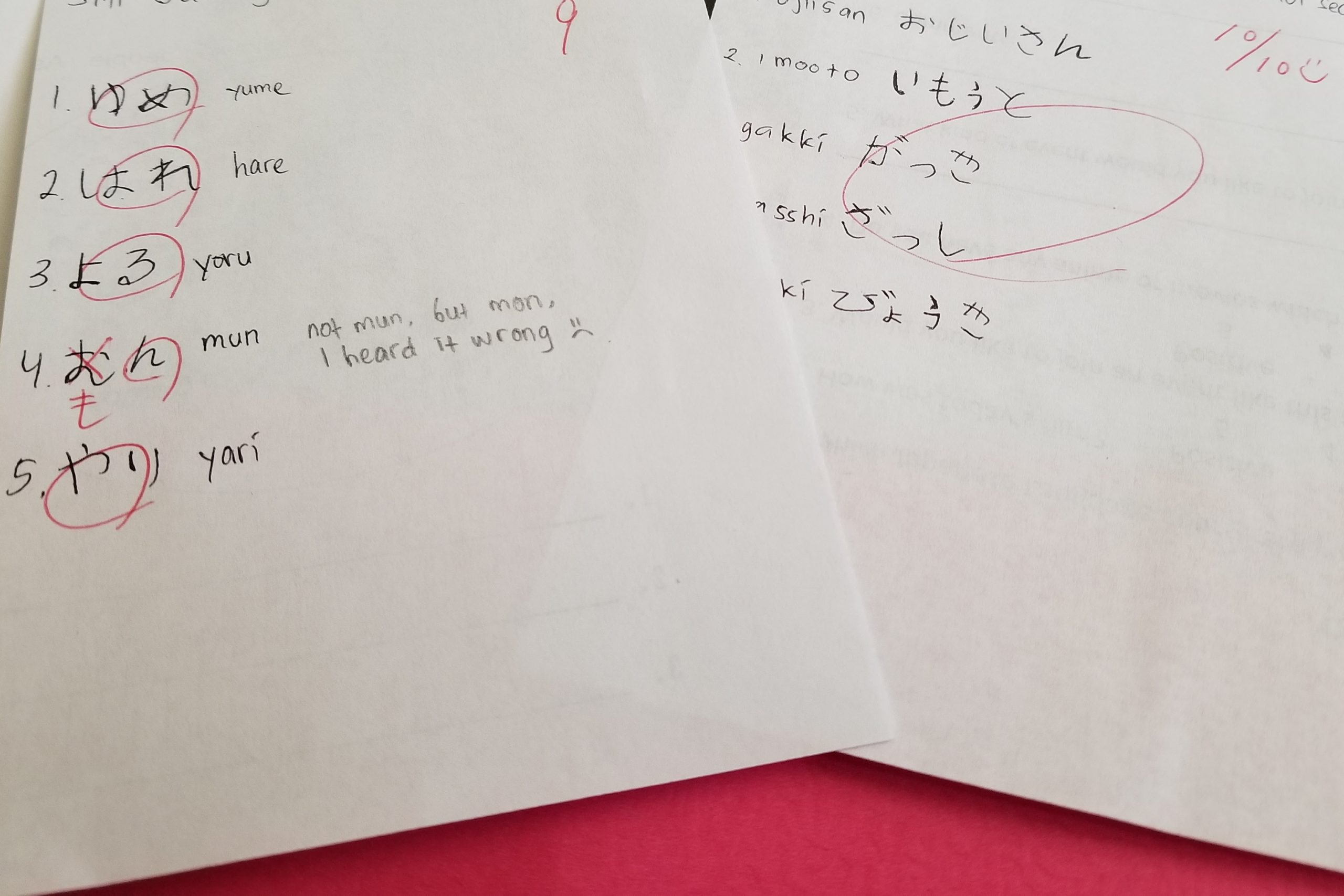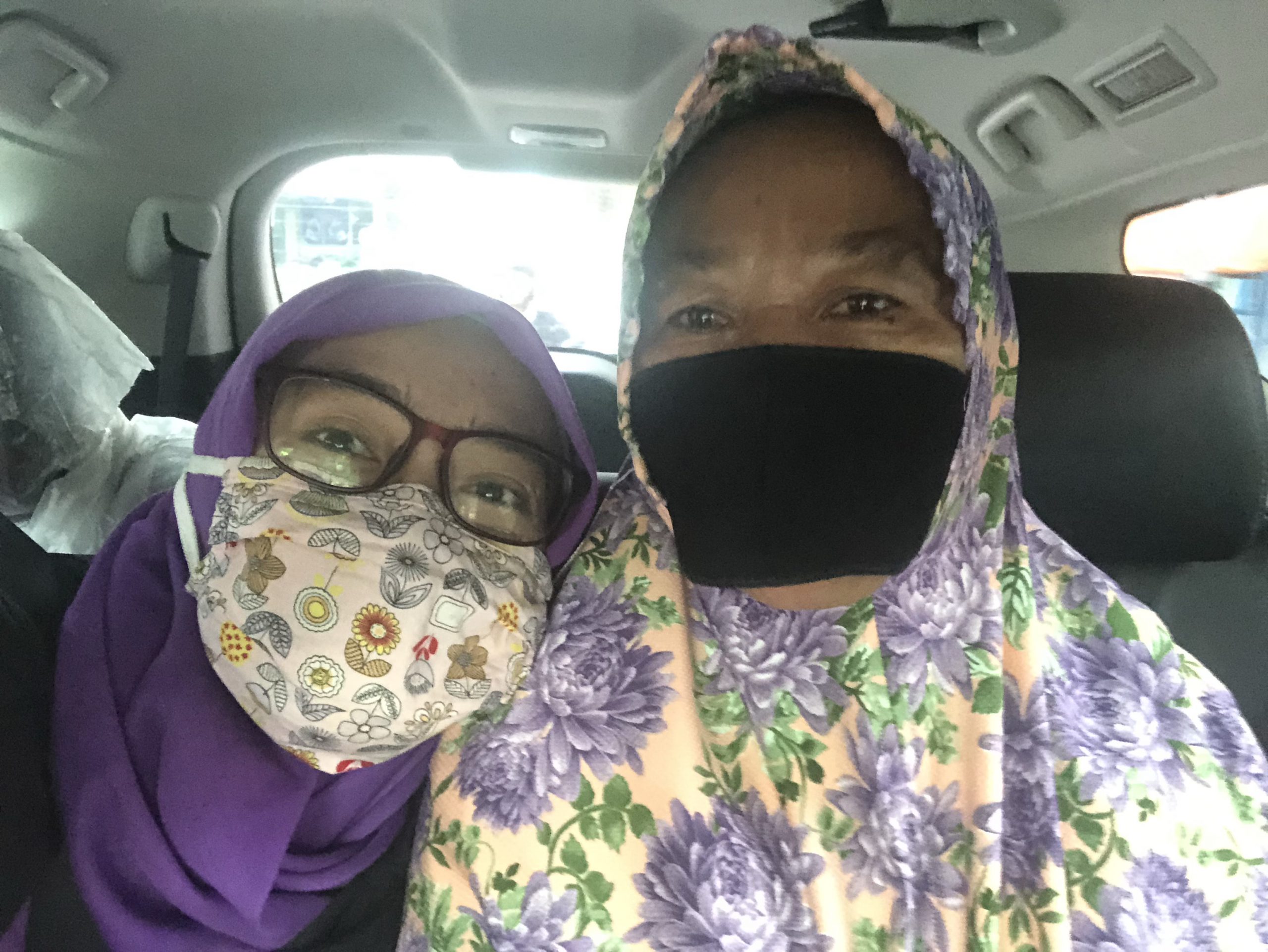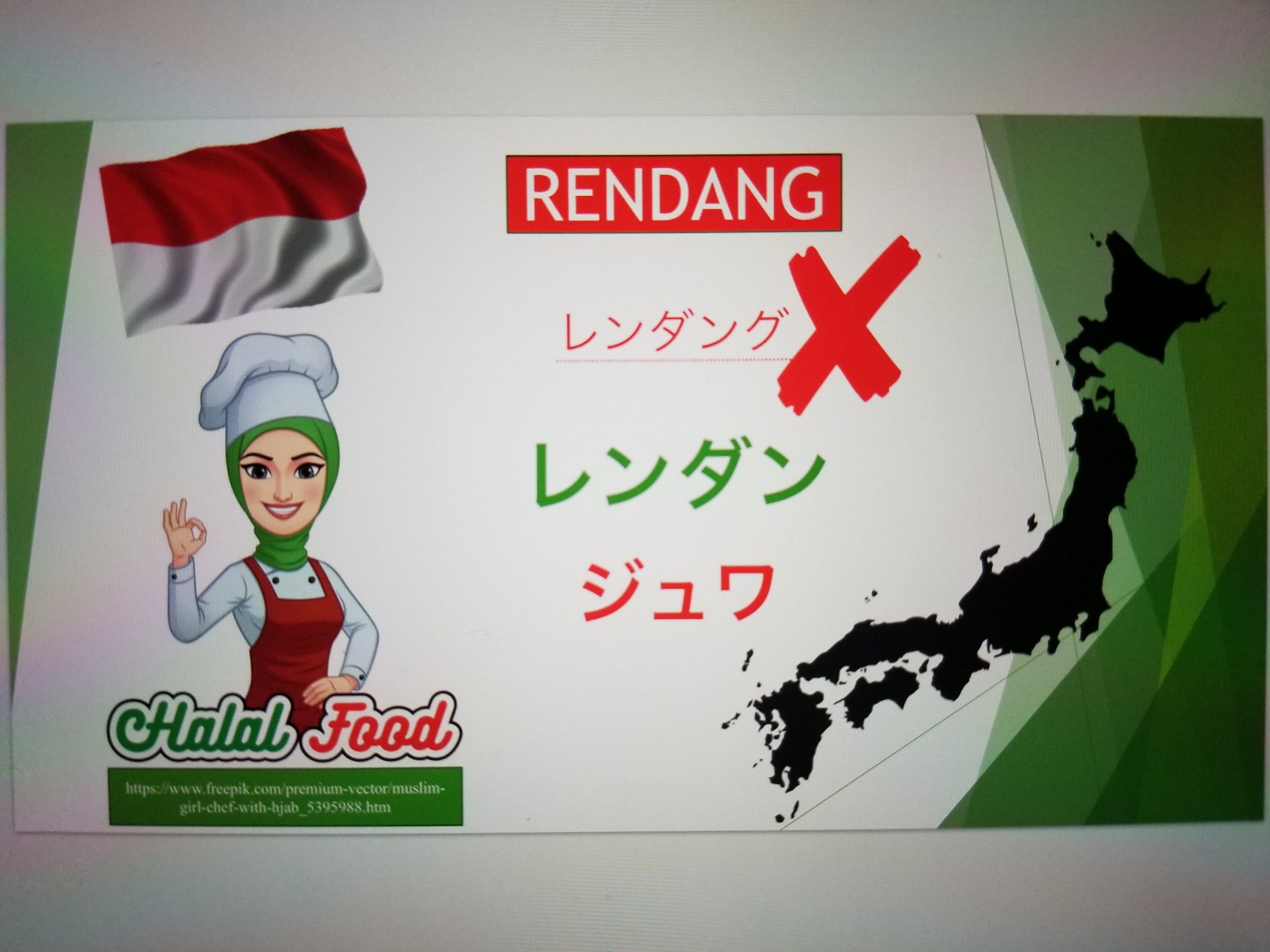Did you wonder what I got for my second quiz? Well, I actually got 100 for my second quiz, where I wrote “Mun” instead of “Mon”. Haha I was so happy but it was for a bit because the teacher quickly made a revision and changed it to 90 🙈😂🙈😂 I knew because every time my grade in the website is updated, I get the notification sent to my email, so I knew that, even though my score is now 90, it was written 100 before. I’m still happy, though 😁 Maybe the teacher was conflicted. First, I thought she gave me 100 because I wrote the hiragana characters along with the Romanized letters that I thought I heard. So my writing for “Mun” is not because I don’t know how to write “Mon” but because it’s “Mun” that I heard, not “Mon”. So technically I didn’t write “Mun” or “Mon” incorrectly. I wrote “Mun” correctly, except that it’s “Mon” that she wanted me to write. If it was counted wrong, I should be getting 80 because there are 5 items, so 1 item should be worth 20 points. But maybe because I got to write the “n” correctly, that’s why it’s counted as half wrong or half right, so they counted each character not each word. (Man, the old me might have been resenting this and blamed the teacher for pronouncing “Mon” like “Mun” 🙊🙈🙈😂😂😂😂) But no, I’m still happy with my learning 😊 (Maybe I should move and sit in the front so I can hear better?)
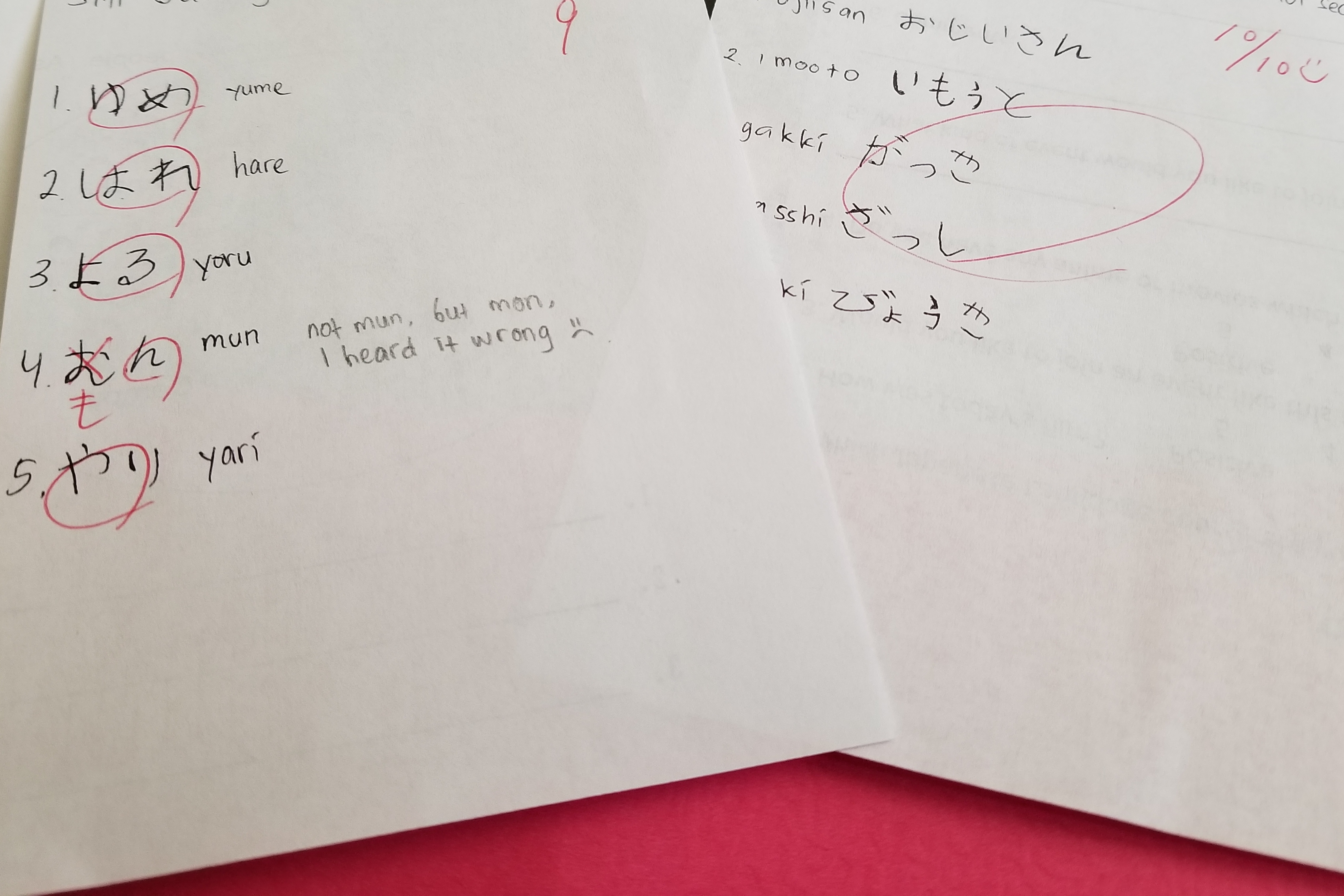
Then for my third quiz, I was actually worried that I was going to hear them wrong again. This time it would be harder because it included the long vowels, double consonants, and the glides. And by the time I was learning this, I realized that Japanese is a “language of sound and tone.” This is my own terminology; I’m not sure if it is correct; I am not a linguist anyway. But let me tell you why I think it is so. Well, in my language, Bahasa Indonesia, whether a word is pronounced short or long, the meaning will remain the same. It is the same as words in English. Let’s say we pronounce “mother” short and “mooooother” or “motheeeeer” long, the meaning will be the same: mother. In Japanese, it is not the case. Say, for instance, “Obasan” and “Obaasan” have two completely different meanings. “Obasan” means “aunt” while “Obaasan” means “grandmother”. It might be easy to differentiate the two when we see the writing because they are written differently, but when it comes to audio/listening, well, I know I’m doomed. Like, how am I supposed to know which is which? How do I know if what I hear is “Obasan” but not “Obaasan”? In the learning stage we might be able to make “short” and “long” pronunciation as distinct as possible as we can ask the teachers to speak more slowly, but in reality where people speak at normal speed or fast, it must be harder. Or maybe this is because my hearing is not as sensitive (yet?). Gosh, this is really my weakness when it comes to language learning. Let me tell you something: that’s also what happened when I was learning English. I’d never got an A for my Listening Comprehension classes T_T It’s not my comprehension, really. It’s my hearing, it’s not sensitive T_T And for it to get sensitive, I’ll need a lot of practice so it can get used to it and can finally distinguish which from which. And oh, there are also words that are written exactly the same but said in different tones and stresses, they will have different meanings. For example is the word “ame”; I forgot which part raises the tone and which part has the tone falling but one means “candy” and the other means “rain”. So you see? I’m not sure how I’m gonna deal with this later 🙊🙈🤦
So yeah, I was worried about my third quiz. Fortunately, we were given a list of words which we could study at home. Some of the words would be used for the quiz. So I studied the words, memorized how they were written in the Romanized version, so I know which word has long vowels or double consonants, and which word uses glides and which part. Like for example, I memorized how “gakki”, “byooki”, “shippo”, “ryoo”, etc. were written in Roman/Latin alphabets. I wasn’t worried about my hiragana (I was bragging here, please be proud of me 🙈😂🙈😂✌ ), so as long as I know how they were written in roman/latin alphabets, I’d be fine. But if I didn’t memorize it and hear the word wrong when pronounced by the teachers, I’d be doomed since it means I’d write it wrong too. But guess what? On the day of the third quiz, the teacher (C-sensei) didn’t say the words for the quiz. Instead, she displayed the Romanized words on the screen and asked us to write the hiragana. Hallelujah! Glory, glory! I was worried for nothing. LoL I mean, when I can see the words, I can definitely write the hiragana! So yeah, I’m more a visual learner I guess. I mean, I should work on my auditory since that’s where I am weak at, but in general, the visualization always helps me learn better since it’s easier to remember. For me, at least 😊 But well, as you might have guessed, I got 100 % for my third quiz ^^ I am so happy ❤
And today I had a test on Chapter 1. Previously the teacher told us how the test would be like. There would be listening tests on useful expressions that we have learned in Chapter 1 and completing the hiragana chart. I wasn’t worried much because mostly I have known the useful expressions. Maybe more than half? I already knew the greetings such as good morning, good afternoon, good night, nice to meet you, bye, see you later, and other expressions like apologizing and thanking and how to respond to them. (Wait, have I told you this?) But well, there are also some Japanese words/phrases that I have known but have not been taught in the class. Not yet. (It’s called the power of anime/movie/drama!!! 🙈😜✌) So yeah, I wasn’t worried about my test. And the truth is, I finished earlier. It took me less than 15 minutes to do the test and I am confident that I did great. Let’s see when it’s returned with the grade later. But finger-crossed, I’ll get 100 🙈😂🙈😂 Yes, I can’t help bragging. Sorry. Let me do so while I have the opportunity. Later when it’s getting harder and I can no longer brag, I won’t brag for sure 🤣😁🙈
And, so, let me tell you about the test. So, first, it’s listening. I thought it was going to be a kind of recording, but no. The teacher said all the words, so it was relieving. Remember, when we learn a language, it is a matter of “getting used to it”, which is why even if you speak English in the US, if you’re not used to listening to Australian or British or Scottish English, there’s no guarantee that you’ll immediately understand; it will take some time for you to get used to it and to finally understand. Trust me, I’m a language learner (and teacher). So yes, because I’ve been used to A-sensei’s speaking Japanese, it was easier to hear and understand. (Yes, we had the third quiz with C-sensei, and the test today with A-sensei). But let me tell you my observation (or analysis?) on this part. So, for the listening part, we were asked to match what we heard with the corresponding pictures. For example, when the teacher said “May I use English?” in Japanese, we should find the pic that suits that. You know the problem with this? We must think twice. First, we should understand the meaning. Then we must find the picture that reflects the meaning. This is to say that even if we know what the words/phrases mean, we can still answer incorrectly if we don’t choose the right corresponding picture. Well, yes, we’ve practiced using the pictures too but I think it would be easier to just write the meaning of the Japanese words/phrases instead of picking the pictures. I mean, I was having a bit hard time to find the right picture and be sure that it is the correct one. And as usual, this gets me to revisit what I did as a teacher, too. Sometimes (or maybe often) I do things like that, i.e. using pictures thinking that they’ll help students to comprehend the meanings more asily. But now that I think of it, maybe it’s not always the case. What if the students see, understand, and interpret the pictures differently than what I do? Won’t it make it more difficult to understand the words or the context? So maybe, when we teach, it’s also better to ask students if they find the pictures helpful or, on the contrary, even more confusing.
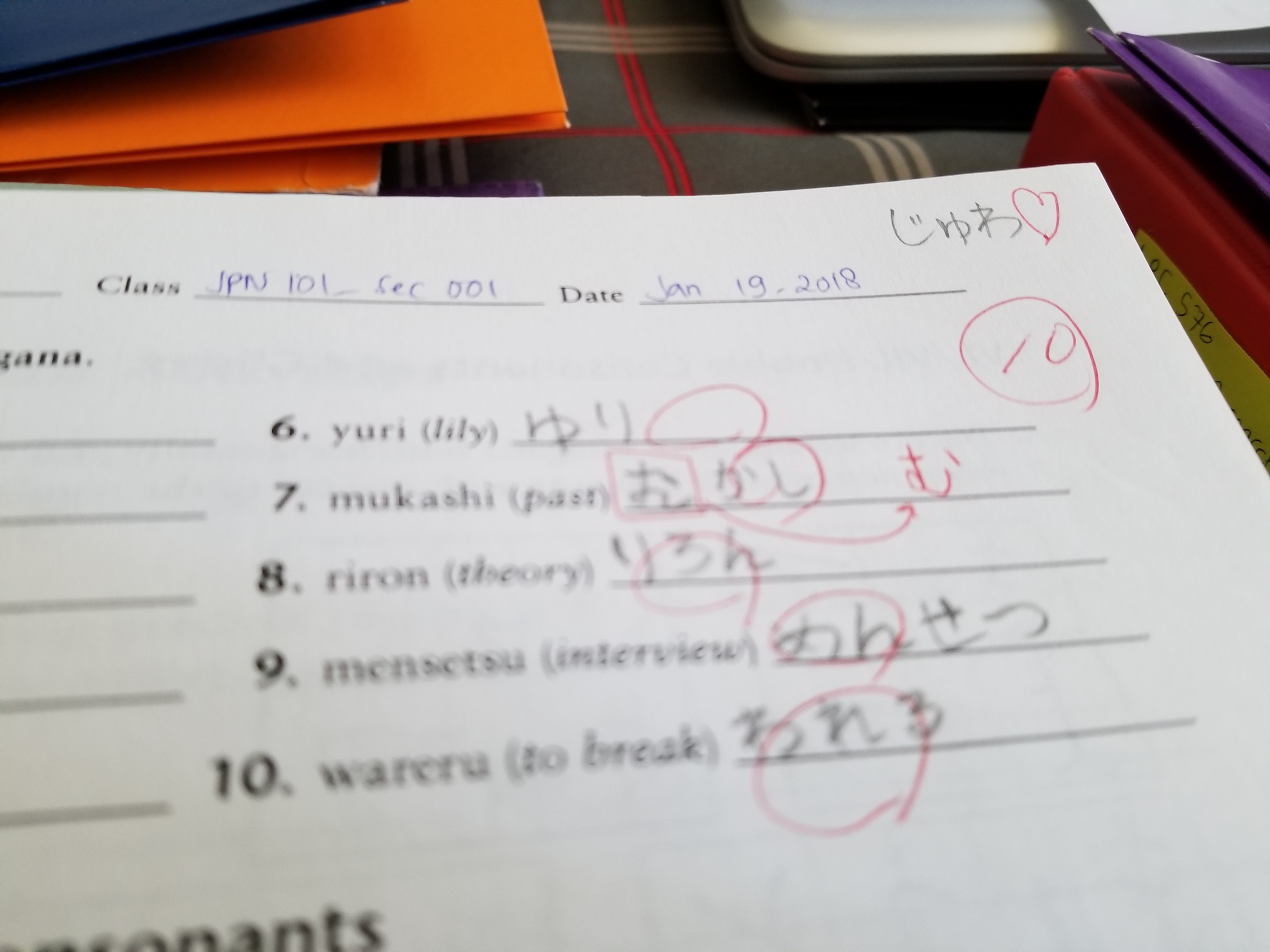
Anyway, if I should sum up, my greatest achievement in this first three weeks of auditing Japanese class is my ability to read and write hiragana. I learned how the phrases (that I had already known before) are written. I learned new phrases, too. So yeah, I am happy. But I am also worried. I mean, it seems easy in the beginning, but I don’t know how much harder it will be as the semester goes considering that my required courses would be killing, too! Gosh. Wish me luck 😊
PS: I got a ❤ sign from B-sensei on my homework 🙂 That was because I wrote my name in hiragana. At that time, we haven’t been taught to write the letter that I used to write my name, so maybe she thought it was kind of a dedication, commitment, or accomplishment. Hhe It’s nice to get such “affectionate” sign/dialog from the teacher. I know it makes me happy. I wonder if my students were happy to get one from me. I mean, I did such things a lot when returning my students’ work. I used heart and emoticons a lot 🙂 But hey about my hiragana name, if you knew me, you know that’s the first thing I’d do. As soon as I got to see the hiragana table/chart, I was looking into the characters that I could use to write my name 😀 Well, actually I haven’t been able to write my complete name in hiragana. It seems that Japanese doesn’t have word that ends with a consonant. I mean, in English we have “bag, meat, mattress, clock, etc.” (you see how they are pronounced and end with consonant at the end, right?), in Japanese, the only ending they have is only “n” such as “kaban, sekken, kirin, yakan, etc.” But maybe it’s because we haven’t learned the others. We’ll see. I’ll keep you updated ^^
